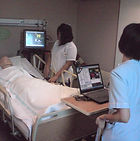Hospital Based Education and Simulation Integration
Here are some hospital based programs that are integrated with simulation - uniprofessional and interprofessional.

Rapid Escalation Criteria Protocol
I had the privilege to initiate, conduct and oversee the development of this program during my tenure in NUH since 2007. The Rapid Escalation Criteria (REC) Clinical Drill was launch on 26 March 2008 in National University Hospital, Singapore. NUH did not have a training laboratory before 2009. Hence, simulation in-situ is the solution to training the REC protocol. The program started with the structure of common clinical deterioration scenario. 5 scenario were pre-programed on the SimMan Mark 2 platform. The SimMan Mark 2 was borrowed from the hospital collaborator - NHG College. The SimMan Mark 2 was a wired system, which we setup on a "training bed". The cable position was almost permanent that we fixed, tied down and hid it under the bed mattress.
For 3 consecutive years, the nurse educators travel around 30 adult wards within NUH to train REC. Since the drills were conducted within the ward, we garnered more than 80% of partcipation rate. The training outcome include increased call for REC team activation, reduced code blue activation, increased SBAR communication via the phone, increased in nurses' confidence in providing immediate nursing interventions to stabilize patients.
The nursing simulation program expanded, the simulation faculty development program was initiated to induct clinical instructors to take on the REC at their ward level to continue REC training for their ward staff. At present, NUH has more than 70 simulation trained clinical instructors. The system is upgraded to include 2 SimMan Essential systems to cover REC trainings.

TeamSTEPPS
Fundamentals
TeamSTEPPS: Team Strategies and Tools to Enhance Performance and Patient Safety is a well-researched communication based training for healthcare team members. The set of communication tools developed in the US has made its way to Singapore in 2007. The initial training phase engaged healthcare leaders in a conference style training format to allow assessment of the tools for its relevancy and feasible implementing in Singapore. I supported the conference training through scenario design and executing it on SimMan Mark 2 simulator.
Following the launch, we took the learning back in NUH to implement a hospital wide TeamSTEPP Fundamental / Foundation course. The course adopted high fidelity simulation in portraying 5 clinical situations. The hospital sentinel events were used as teaching scenarios and to enhahce illustrations on the importance of communication in healthcare.
NUH rolled out 6 to 10 TeamSTEPPS training sessions every year. This is a full day course that enrolls 24 interprofessional participants from medical, nursing and allied health. Participants are grouped in 5s to work on 2 to 3 clinical scenarios. The faculty lead in debriefing the team after each scenario.
The NUH Intensive Care Education Group which I was leading, was instrumental in coordinating the TeamSTEPPS training programs in NUH. The program is nursing driven; working with the hospital's Patient Safety committee, the program has trained more than 400 clinicians. The program is still in effect at present.

Moderate Sedation for Nurses
The moderate sedation course for nurses is a mandatory course under JCI SQE for all nurses who administer sedation. The course is deliverd through a short didactic followed by 3 skills station focusing on indentifying respiratory distress, Airawy management and assisting in intubation. The simulation modalities used for cultivating hands on are task models for airway management and computerised manikins for respiratory distress and initial management.

Life Support Trainings
Simulation has long been used for many clinical skills based training. Life support education utilises a wide range of education hardware dependning on the objectives of the training. Apart from the core life support skills, training are evolved towards life support protocols and workflow within the institution. In Situ life support trainings or drills are more realistic when the policy is integrated as part of the training.
